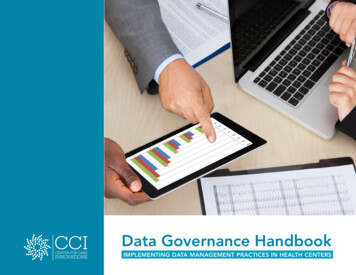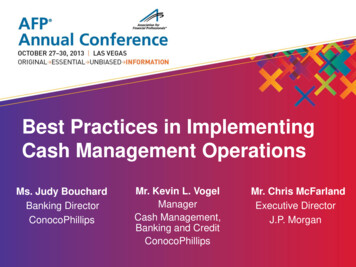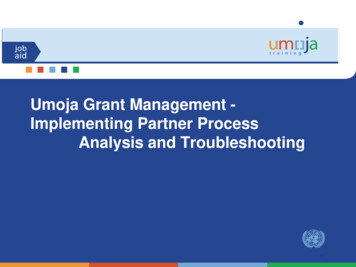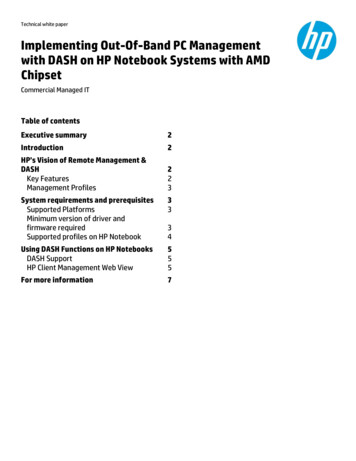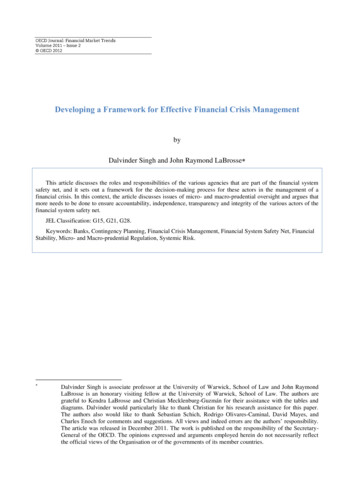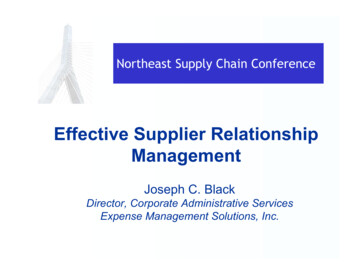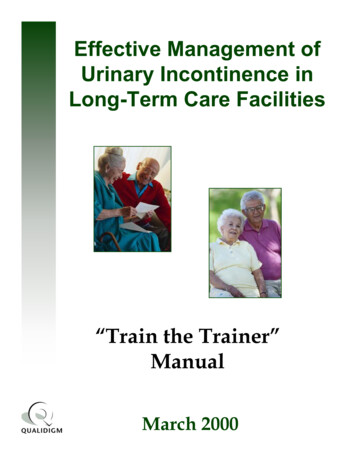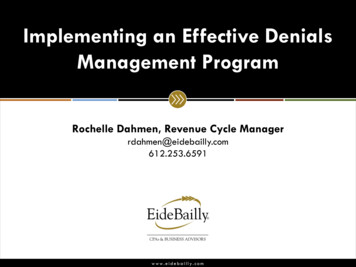
Transcription
Implementing an Effective DenialsManagement ProgramRochelle Dahmen, Revenue Cycle ailly.com
Agenda Introduction Denials - An Overview Defining Denials Understanding Your Denials Managing Your Denials Conclusion Questionswww.eidebailly.com
Denials – An Overview
Denials – An Overview According to the American Medical Association (AMA), 25– 30 percent of the country’s total health care expendituresare direct transaction costs and inefficiencies associatedwith the “claims management revenue cycle”. Substantial amount of resources are utilized whilemanaging the basics of the claims revenue cycle Lack of payment transparencyInaccurate or unfair paymentAdministrative hasslePayment reconciliation and claims follow-upwww.eidebailly.com
Denials – An Overview According to recent estimates, gross charges denied bypayers has grown to an alarming 15 to 20 percent of allclaims submitted The average cost to rework a claim is 25.00, according tothe Healthcare Financial Management Association (HFMA) As many as 65 percent of claims denials are never workedresulting in an estimated 3 percent loss of net revenue Roughly 67 percent of all denials are appealablewww.eidebailly.com
Denials – An Overview In its most recent National Health Insurer Report Card from2013, the AMA reported Medicare most frequently deniedclaim lines at 4.92 percent, followed by Aetna at 1.5percent, United Healthcare at 1.18 percent and Cigna at0.54 percent Top Claims Adjustment Reason Codes : 16 – claim lacks information or has billing/submission errors 96 – non-covered charge(s) 204 – this service/equipment/drug is not covered under thepatient’s current benefit plan 197 – precertification/authorization/notification absentwww.eidebailly.com
Denials – An Overviewwww.eidebailly.com
Denials – An Overview Accurate claims payment is also measured as part of theinsurer report card, with the following CBS)97.4692.6097.9285.21UHCMedicareContracted fee schedule match 6
Denials Defined
Denials DefinedDefinition: Denial of a claim is the refusal of an insurancecompany or carrier to honor a request by an individual, orhis or her provider, to pay for a health care servicesobtained from a health care professional.www.eidebailly.com
Denials DefinedA true denial, or non-payment of a claim or claim line, isfairly obvious to detect but other payment and revenueopportunities should be monitored in the process as well Underpayment/Overpayment – inaccurate payment froma difference in contract interpretation, pricing errors orother payment issues Lost Revenue – can be in the form of undetected paymenterrors, incomplete or inaccurate billing, services missingfrom the billwww.eidebailly.com
Denials DefinedCommon Denial Type Definitions Soft Denial – a temporary or interim denial that has thepotential to be paid if the provider takes effective followup action. Appeal not required. Examples: Pending receipt medical recordsDenied due to missing or inaccurate informationCoding or charge issuesPending itemized billPending receipt of invoicewww.eidebailly.com
Denials DefinedCommon Denial Type Definitions – Continued Hard Denial – a denial that results in lost or written-offrevenue. Appeal is required Examples: No pre-authorizationNot a covered serviceBundlingUntimely filingwww.eidebailly.com
Denials DefinedCommon Denial Type Definitions – Continued Preventable or Avoidable Denial – a hard denial resultingfrom action or inaction on the part of the provider ofservices Usually involve elective services that could have beendelayed or deferred Account for about 90 percent of denials Examples: Registration inaccuraciesIneligible for insuranceInvalid codesMedical necessityCredentialingwww.eidebailly.com
Denials DefinedCommon Denial Type Definitions – Continued Clinical Denial – denials of payment on the basis ofmedical necessity, length of stay or level of care. May be concurrent (while patient is still in-house) or retrospective (after the patient is discharged) Typically begin as a soft denial Delay of payment where further medical or clinicalclarification may be requiredwww.eidebailly.com
Denials DefinedCommon Denial Type Definitions – Continued Technical or Administrative Denial – a denial in which thepayer has notified the provider, by way of remittanceadvice, with specific information describing why the claimor item was denied. Typically done via remark code or reason code Includes delay of payment where additional documentationis needed Coding clarification Requests for medical records Itemized billswww.eidebailly.com
Denials DefinedCommonly Misclassified Denials Lack of Coverage – a denial that results when non-coveredservices are provided Usually the result of insufficient or ineffective insuranceverification Unpreventable – hard denials resulting from the deliveryof emergency services that could not have been delayed Demand – claim sent to Medicare specifically for thepurpose of obtaining a denial when a patient had signedan ABNwww.eidebailly.com
Denials DefinedCommonly Misclassified Denials Short Pay – denials that occurs when a payer incorrectlypays a claim Invalid case rate, per diem, or fee schedule amountwww.eidebailly.com
Understanding Your Denials
Understanding Your DenialsMeasure - Tracking and Trending Before we can do anything to manage and prevent futuredenials we first need to understand the types and volumes ofdenials currently occurring Methods of Tracking and Trending: Automatically through ERA Automatically or manually through EOBs Automated tracking of denials does not always work effectively Creation of a denial tracking worksheet Manual spreadsheet, allows more detailed data collection Payer, reason for denial, ability to appeal, date of denial, billingdate, amount denied and amount recoveredwww.eidebailly.com
Understanding Your DenialsMeasure - Tracking and Trending Track denials for at least three months to develop abaseline ratio of denials to charges Review data and categorize top payers and reasons fordenials In terms of both volume of denials and dollar amount ofdenials Use the 80/20 rule to prioritize and focus efforts on denialreduction and eliminationwww.eidebailly.com
Understanding Your DenialsExample Breakdown of Denialswww.eidebailly.com
Understanding Your DenialsAnalyze – Where do we need to focus our efforts Cause and effect relationships create a tangled web Spreads the blame for denials across the revenue cycle Also the place to determine the source of denialswww.eidebailly.com
Understanding Your DenialsAnalyze – Where do weneed to focus our efforts Map out current clean claimprocess to identify anyvulnerabilities in the process Note any problems thatcould potentially occur thatcould result in a denialwww.eidebailly.com
Understanding Your DenialsAnalyze - Perform a Failure Mode and Effects Analysis(FMEA) for each step that could potentially result in a denial Failure modes – what could go wrong? Failure effects – what would be the consequences of eachfailure? Rate the severity of the effect on a scale of 1-10 Failure causes – why would the failure happen? Rate the likeness of the occurrence of failure on a scale of 110 Detection mode – what controls are in place to prevent thefailure from occurring or detect it should it occur? Rate how easy it is to detect failure on a scale of 1-10www.eidebailly.com
Understanding Your DenialsExample of a Failure Mode and Effects Analysis (FMEA)www.eidebailly.com
Understanding Your DenialsAnalyze - Set Your Priorities Calculate a risk priority number (RPN) RPN severity x occurrence x detection Sort the FMEA in descending order by RPN. Highlights the areas were corrective actions can be focused Set priorities on the biggest problems first Use the 80/20 rule as a cut off point to start As a rule of thumb 80 percent of issues are caused by 20percent of the potential problemswww.eidebailly.com
Managing Your Denials
Managing Your DenialsImprove - Determine Corrective Actions Needed from FMEA Generate appropriate corrective actions for: Reducing the occurrence of failure modes Improving the detection of failure modes Assign responsibility for each of the actions Set target completion dates Once completed, reassess and rescore the severity, probabilityof occurrence and likelihood of detection for the top failuremodes Determines the effectiveness of the corrective actions takenwww.eidebailly.com
Managing Your DenialsImprove – Develop a Zero Tolerance mindset forpreventable or avoidable denials Totally within the control of an organization Caused by either actions or inactions in the revenue cycleprocess Two questions that should be asked when a denial occurs: Is the denial preventable? How could a preventable denial have occurred if we hadthe appropriate process and controls in place?www.eidebailly.com
Managing Your DenialsImprove – Develop a Zero Tolerance mindset forpreventable or avoidable denials Process improvement efforts should focus on breakdowns indenials prevention processes These should be identified in the FMEA Examples: Communication issues Verification of patient information and insurance Inaccurate or missing documentationwww.eidebailly.com
Managing Your DenialsImprove - Prevention Areas Throughout the Revenue Cycle Patient AccessAncillary ServicesCase ManagementHealth Information ManagementPatient AccountingInformation SystemsCompliancewww.eidebailly.com
Managing Your Denials Patient Access – Scheduling Potential Denials Failure to obtain prior authorization / pre-certification Inpatient-only procedures preformed on an outpatient basis Accurate patient data not captured prior to the visit Best Practices Ensure staff are familiar with payer contract requirements Non-emergent services scheduled at least a day in advanceto allow time to obtain prior authorization Electronic “hard-stop” for surgical codes on inpatient only list Medical necessity is validated OK to delaywww.eidebailly.com
Managing Your Denials Patient Access – Pre-Registration Potential Denials Pre-certification not obtained Non-covered services Invalid insurance information Best Practices Complete insurance information is obtained Line item level insurance verification is performed Non-covered services reviewed with patients so self-paycollection process can beginwww.eidebailly.com
Managing Your Denials Patient Access – Registration Potential Denials Pre-certification is not obtained Member is not eligible under coverage provided Non-covered services Best Practices ABNs are issued for non-covered servicesRegistrar is focused on financial clearanceStaff trained to recognize complete ordersInsurance verification performedPatient demographics validatedwww.eidebailly.com
Managing Your Denials Ancillary Services Potential Denials Medically unnecessary services Failure to obtain necessary authorization Best Practices Staff are educated about National and Local CoverageDeterminations and can explain coverage to patients Trained to issue ABNs Staff trained to recognize complete and accurate orderswww.eidebailly.com
Managing Your Denials Case Management Potential Denials Clinical documentation does not support stay or level of careprovided Clinical documentation is not provided in a timely manner Best Practices Reviews inpatient admissions and observation stays prior todischarge to verify stay meets criteria for coverage Communicates with physician if stay does not meet coveragecriteria Provides information to payers in a timely fashion All denied services are appealed Initiates discharge planning at admissionwww.eidebailly.com
Managing Your Denials Health Information Management Potential Denials Coding issues Untimely submission of requested medical records Best Practices Records are coded in a timely fashionCoding quality is validated – outside firm is preferredPhysician are queried for unclear or missing documentationPhysician documentation education is providedCan remove incorrectly posted charges when identifiedwww.eidebailly.com
Managing Your Denials Patient Accounting Potential Denials Untimely filing Incorrect codes due to chargemaster issues Incorrect or missing billing edits in claims scrubber Best Practices Rejected claims are corrected in a timely mannerMonitors incorrectly entered chargesDenied claims are appealedFluent in payer contractsContract management software is currentChargemaster is audited and updated regularlywww.eidebailly.com
Managing Your Denials Information Systems (IS) Potential Denials Interface issues resulting in incorrect or incomplete informationtransfer Inadequate reporting resulting in poor denials analysis Best Practices All IS systems installed timely and upgraded as needed Ad-hoc reports prepared and audited for accuracy Extract denial information from electronic 835 remittanceadvice Documentation collected electronicallywww.eidebailly.com
Managing Your Denials Compliance Best Practices Appropriate audits of performance are conducted: Remittance Advice ReviewsWrite-off AdjustmentsZero Payment ClaimsRegistration and Insurance Verification QualityCoding AccuracyChargemaster Accuracy Educational programs offered as needed for non-medicaland medical staffwww.eidebailly.com
Managing Your DenialsControl – How do we know improvements are working? Well-established process for updating Denials Tracker andcreating new action plans as needed Creation of a Revenue Cycle team Benchmarking is critical Short-term goal should be an improved denials ratio fromone month to the next Strive towards industry standard Key Performance Indicators(KPIs)www.eidebailly.com
Managing Your DenialsKey Performance Indicators for Denials Medicare Return to Provider rate (RTP):Overall claim denial rate (% of total claims submitted):Denial write-offs (% of monthly net revenue):Clean claim submission rate:www.eidebailly.com3.0% 5.0% 3.0% 85.0%
Conclusion
ConclusionAddressing denials can be an extremely large project Expect significant time and resource commitment at the start Payer requirements change frequently Need to stay on top of changes to optimize revenue capture Significant return on investment may be achieved Get the right players on the team – all areas of revenuecycle are represented Create an environment accountability Provide feedback to staff – celebrate the victories Start tracking denials as soon as possiblewww.eidebailly.com
Questions?This presentation is presented with the understanding that the information contained does not constitute legal, accounting or other professional advice. It is not intendedto be responsive to any individual situation or concerns, as the contents of this presentation are intended for general informational purposes only. Viewers are urgednot to act upon the information contained in this presentation without first consulting competent legal, accounting or other professional advice regarding implications ofa particular factual situation. Questions and additional information can be submitted to your Eide Bailly representative, or to the presenter of this session.www.eidebailly.com
Thank You!Rochelle Dahmen, Revenue Cycle ailly.com
www.eidebailly.com Rochelle Dahmen, Revenue Cycle Manager rdahmen@eidebailly.com 612.253.

